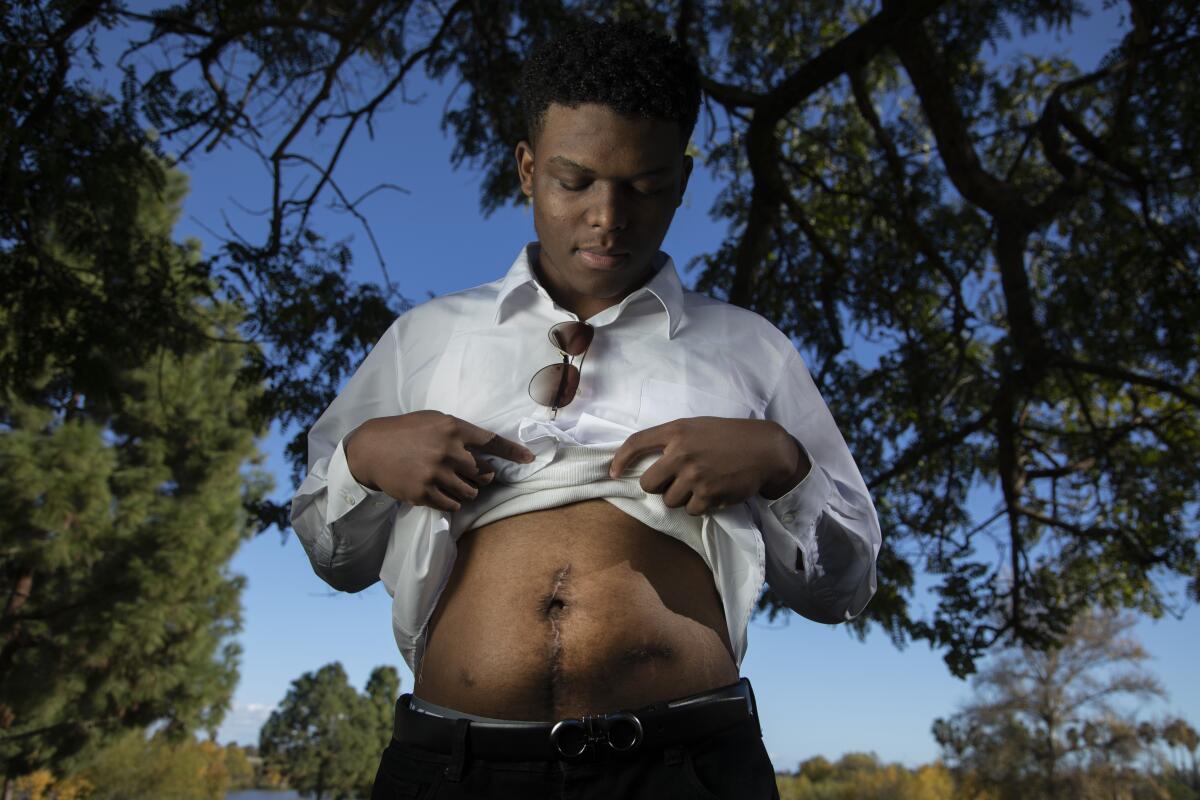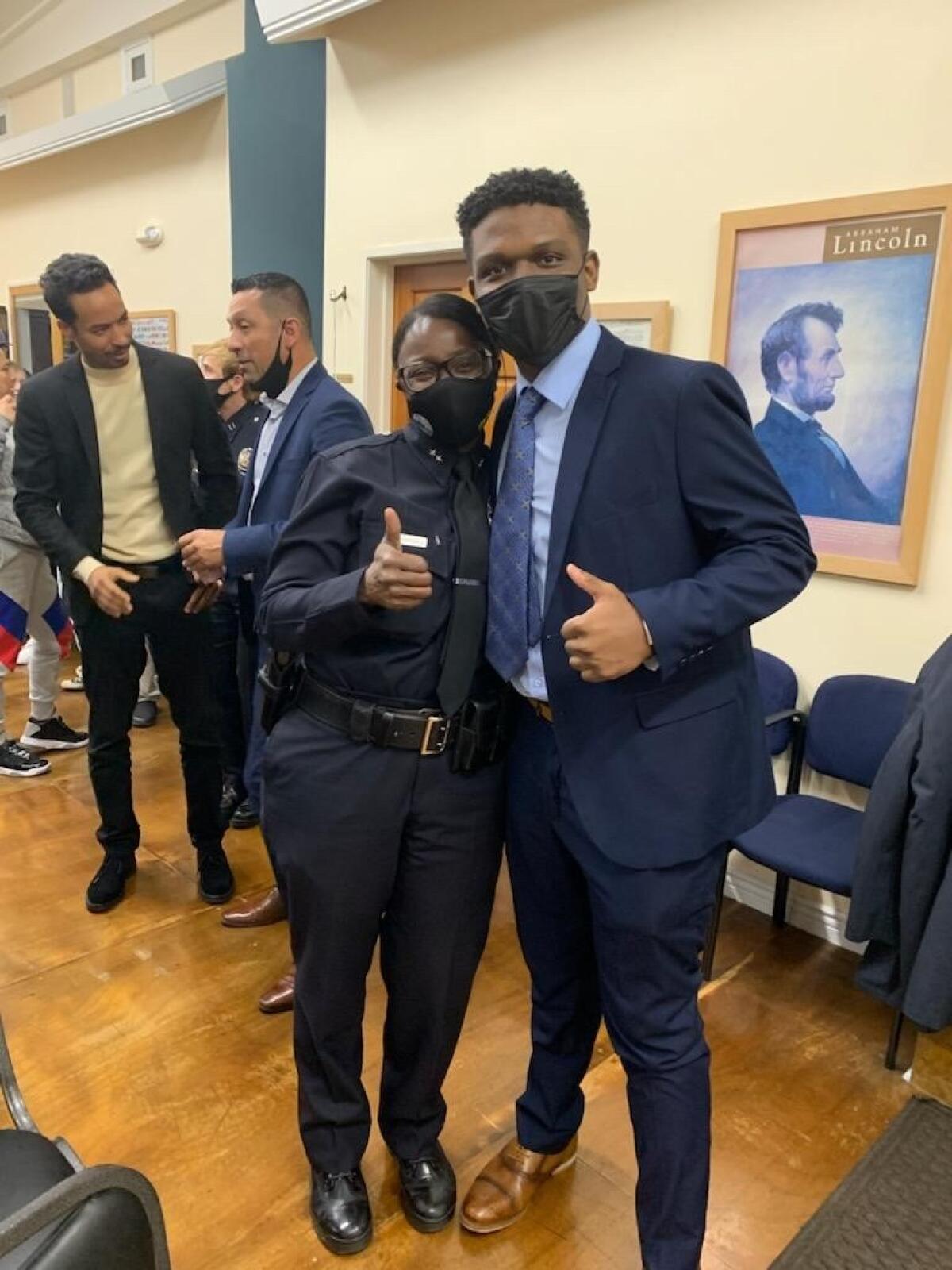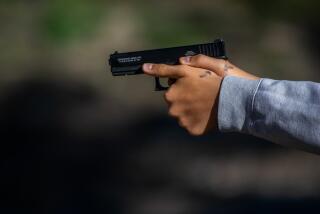Gun violence hits 15-year high in L.A., taking lives and erasing hard-fought gains

- Share via
Sean Reynolds almost lost his life over a PlayStation.
The 17-year-old high school senior had arranged to sell his gaming console through the app OfferUp, and agreed to meet the buyer — another teenager — near a public housing complex in Watts. He intended to save the cash he earned for college expenses that fall.
Instead, one of two teens who met Reynolds at his car that hot day in May pulled out a gun and shot him, the bullet ricocheting off his hip and fragmenting through his abdomen. As he lay on the ground bleeding, he said, the second teen urged the first to fire again.
“Finish him off,” he heard the boy say.
“I was in shock,” Reynolds, now 18, recalled in a recent interview with The Times. “It was a lot to process.”
Reynolds, who was badly wounded, is among more than 1,400 people who survived shootings in L.A. in 2021 — the second year in a row in which gun violence has increased in the city.
Had things gone differently — and they easily could have, given his serious injuries — Reynolds would have been among the nearly 400 people killed in L.A. this year, whose deaths mark a more than 50% increase in homicides since 2019.
“We’ve seen all different types of surgeons,” said Qiuana Williams, Reynolds’ mother. “After reading his medical documents, they all look at him like he is a walking miracle.”

Amid a pandemic that has ravaged people’s financial and emotional reserves and undermined long-standing initiatives to stem violence, families like Reynolds’ are persevering through surgeries, physical therapy and the emotional labor of trying to pull their lives back together after being blindsided by bullets.
Other families — more than in any other year in L.A. since 2007 — were forced to plan funerals and process their first holiday season without sons, daughters, brothers and parents, whose lives were snatched away, mostly by gunmen.
The city has seen nearly 400 killings at the end of 2021, a staggering loss of progress in reducing such violence over the last 15 years. As of Dec. 29, there had been 392 homicides — the most of any year since 2007.
Young Latino and Black men continue to be overrepresented among the dead. Some of the neighborhoods hardest hit by the far more deadly gang wars of the 1990s are being heavily affected once more. Areas where violence has historically been less common have also seen upticks.
An analysis by The Times of killings in L.A. County through the first 11 months of 2021 showed sharp increases in neighborhoods such as Watts and adjoining Florence-Firestone, which each had more than 20 killings, and in other cities in the broader L.A. region, including Compton and Long Beach, which each had more than 30.
Hollywood saw 10 killings in the first 11 months of the year, compared with four the year prior, according to the data from the county coroner’s office. Hyde Park saw 13, compared with four in 2020, and El Sereno saw eight, compared with three the year prior. Killings also ticked up in neighborhoods like Mid-Wilshire and Echo Park, though in smaller numbers.
The causes are complex and hard to pin down, and have been politicized — exaggerated or minimized — to meet people’s chosen narratives about police, criminal justice and the best path forward. Other parts of the nation have also seen surges in killing, some worse than L.A.’s.
The effects of the violence, however, are clear and inarguable — rippling out from individual incidents in almost every corner of the city to impact not only the victims and perpetrators, but their extended families, neighbors and local businesses, emergency room staffs and the policymakers and police whose job it is to find solutions.
Some this year in L.A. have socially distanced as much out of grief as pandemic propriety, their devastation compounding the year’s isolation. Street corners have turned aglow for the dead in impromptu candlelight vigils in sight of the remnants of memorials past. Doctors and nurses already exhausted by COVID-19’s onslaught have seen new horrors in the faces of children wheeled into their hospital wards with gunshot wounds.
Tina Basquez has spent the last 13 years in the same San Pedro home but is going into 2022 looking for a new place to live, she said. She needs a place without stairs.
In July, her 24-year-old son Vincent, who played four years of varsity football at San Pedro High School, was paralyzed in a shooting that has baffled his family. Police have linked it to a cluster of others that prosecutors allege were all the work of one person, a young man with alleged gang ties whose nickname is listed in court records as “Reaper.”
When Basquez rushed to the hospital on the summer night of her son’s shooting, COVID-19 protocols prevented her from going inside, where she thought Vincent was dying or already dead. She anguished in a parking lot until a surgeon finally came out to tell her Vincent was alive but badly injured.
Ever since, Basquez has traveled back and forth from her home to the hospital and a convalescent facility where her son, who she said did not want to comment, is now staying. She is trying to figure out a way to raise enough money to purchase the medical equipment he will need to move home — including a special motorized bed that sells, used, for thousands of dollars.
Like Reynolds’ mother and many other families of shooting victims in L.A., Basquez started a GoFundMe page to ask friends and strangers to help cover the unthinkable costs of such violence. Some need help covering medical expenses or the lost wages of injured loved ones. Some need help paying for funerals.
Basquez said she is grateful her son survived but saddened by his injuries, devastated for the other mothers she knows in San Pedro whose sons are gone forever, and frustrated with the lack of attention such shootings receive in the city — especially when they involve Black and Latino kids, and aren’t in wealthier parts of town.
“I feel like I’m living a nightmare, like one day I’m going to wake up and hopefully it’s just over,” she said. “It’s just a lot of loss.”
Dr. Kenji Inaba, chief of trauma and surgical critical care at Los Angeles County-USC Medical Center, said County-USC — one of more than a dozen trauma centers in L.A. County — treated 398 gunshot victims last year, an increase of more than 30% over the 296 it treated in 2019.
This year, the hospital had already treated 381 gunshot victims by the end of August and surpassed 2020’s year-end total by September, said Inaba, who didn’t have full 2021 data yet.
“The numbers are definitely increasing,” he said. “On any given day, we could be operating on a gunshot wound and literally the pagers — they’re phones now — they go off and another gunshot or two or three gunshot wounds can come in.”
It’s difficult and fulfilling work, he said — but also extremely trying, particularly as COVID-19 has already left hospital workers “exhausted mentally and physically.”
With gunshot wounds, surgical teams have to “figure out what’s wrong, what the gunshot wound has destroyed and how to piece it back together” at lightning speed, Inaba said.
Inaba pairs that knowledge with what he sees when he works several times a month as a reserve LAPD officer, when he responds to patrol calls and sees firsthand the sort of human dramas and anger that precipitate the gunfire, he said.
He wonders whether, if others saw what he saw, they would take the proliferation of guns in L.A. and elsewhere in the U.S. more seriously.
“Nobody should ever be shot,” Inaba said, “and yet we’re seeing hundreds and hundreds of these patients getting shot.”
Around those victims — and perpetrators — are thousands of others whose lives are shaken.
Lindsay Ratkovich lives not far from a Ralphs grocery store in Mid-Wilshire where, until last summer, she often stopped to talk with Eva Fekete, a woman in her 70s who lived out of her car there and at times in a tent with her companion, an older man she fiercely protected.
The couple never caused trouble, Ratkovich said, and were welcomed by many in the neighborhood. Fekete remembered neighbors’ names and chatted with them about their lives and kids, Ratkovich said, and the neighbors in turn looked out for her, bringing her and her companion food and clean clothes and other necessities.
Then, one day in June, Fekete allegedly shot and killed a homeless man in his 40s before taking off in her car. Ratkovich said Fekete called her on the phone while on the run, too scared to say much but in need of a friend to just have on the line.
Fekete had been robbed of Social Security and pandemic relief money not long before the shooting, Ratkovich said, and she believes Fekete shot the younger man in self-defense during an attempted robbery or assault. Nonetheless, Fekete was arrested and charged with murder. She has pleaded not guilty.
The killing was one of dozens this year in L.A. in which the victims were unhoused. It was also, in Ratkovich’s mind and the minds of many other neighbors who have advocated for Fekete’s release, a tragic incident that revealed in more ways than one the vulnerability of L.A.’s homeless population.
“I know it was self-defense,” Ratkovich said of the shooting. “Of all people who are thrown and tossed away, for Eva to be considered a major criminal is beyond comprehension.”
Ratkovich said the incident has shaken her faith in L.A., and its leaders.
For Reynolds, who was shot for his PlayStation, 2021’s violence has left lasting scars — and not only physical ones — but also driven him forward.
Reynolds was an honor-roll student who had already earned college-level credits and was soon to be on his way to Penn State University when he was shot. He is, by all accounts, a good kid. His principal vouched for him when police came asking questions, and now the police vouch for him, too.
“Sean is an amazing young man with so much promise,” said LAPD Deputy Chief Emada Tingirides, who oversees the LAPD’s Community Safety Partnership Bureau. She got to know Reynolds after the shooting and attended a special high school graduation ceremony for him in his hospital room.

Still, after his shooting, Reynolds had people — even a teacher — suggest he must have been tied up in a gang to have been shot, he said. Others, including medical staff, suggested he was some sort of exception among shooting victims because he was such a good kid.
Those reactions have stuck with Reynolds and his mother, who are Black and found them racist.
“Being a Black male, they’ll assume that it’s something that I might have done” to cause the shooting, Reynolds said.
“Why isn’t he just a victim, which would have been the case if he were not a young African American boy?” his mother wondered.
In part because of such misguided assumptions, Reynolds said, he is tired of talking to people about the shooting, in which a 14-year-old and a 16-year-old were each convicted of robbery, and his recovery. He looks forward to the day when he can tell them instead of all his other accomplishments — which he already has planned out.
Because of all the college courses he’s continued to take through his recovery, he’ll already have upperclassman status whenever he gets to college, which he hopes will be in 2022, he said with a smile one recent afternoon, as his mother beamed.
From there, his goal is to get into a top-tier law school — and then a leading law firm.
“I would like it to be a minuscule part of my life,” Reynolds said of his shooting, “and the rest to be more positive.”
Times staff writer Maloy Moore contributed to this report.
More to Read
Sign up for Essential California
The most important California stories and recommendations in your inbox every morning.
You may occasionally receive promotional content from the Los Angeles Times.











